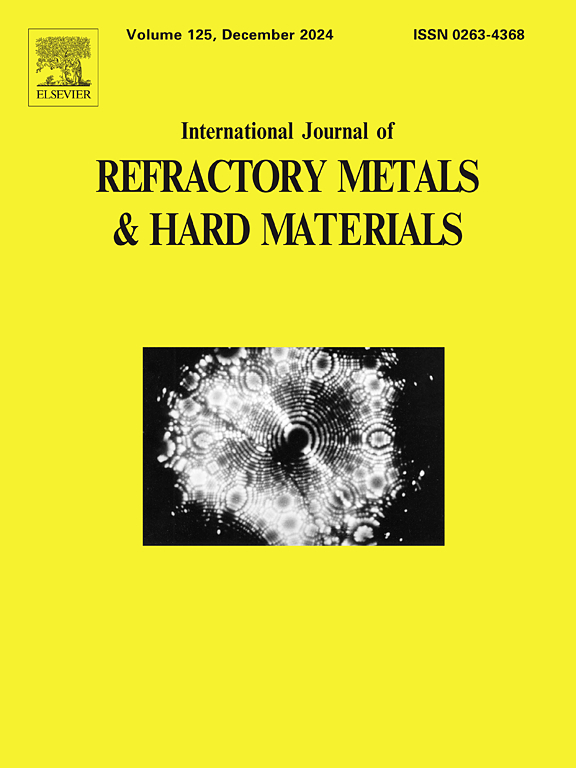High-temperature oxidation performance and corrosion resistance of laser cladded MoNbVTa0.5Six(x=0,0.5) refractory high-entropy alloys
IF 4.2
2区 材料科学
Q2 MATERIALS SCIENCE, MULTIDISCIPLINARY
International Journal of Refractory Metals & Hard Materials
Pub Date : 2025-03-05
DOI:10.1016/j.ijrmhm.2025.107137
引用次数: 0
Abstract
This study investigated the performance differences between MoNbVTa0.5Six (x = 0,0.5) refractory high-entropy alloy coatings fabricated by laser cladding. The phase composition, high-temperature oxidation resistance, corrosion resistance, and microhardness of the coating were explicitly discussed. The phase composition indicates that both are composed of a main BCC phase, and MoNbVTa0.5Si0.5 also has a silicide phase. Due to the dense and uniform SiO2 oxide layer covering the coating surface, MoNbVTa0.5Si0.5 exhibits better oxidation resistance in high-temperature oxidation tests. The mass gain of MoNbVTa0.5Si0.5 is 7.11 mg·cm−2 at 800 °C, which is greater than that of MoNbVTa0.5 (5.24 mg·cm−2). But It is 68 mg·cm−2 and 67 mg·cm−2 at 1000 and 1200 °C, less than 73 mg·cm−2 and 71 mg·cm−2 of MoNbVTa0.5. The electrochemical test shows that the self-corrosion current of MoNbVTa0.5Si0.5 is 0.030 μA·cm−2, the self-corrosion current of MoNbVTa0.5 is 0.032 μA·cm−2. The results of microhardness tests show that the average hardness of MoNbVTa0.5Si0.5 is 772 HV, greater than that of MoNbVTa0.5 (743 HV).
激光熔覆monbvta0.56 (x=0,0.5)难熔高熵合金的高温氧化性能及耐蚀性
研究了激光熔覆制备的monbvta0.5 - six (x = 0,0.5)耐火高熵合金涂层的性能差异。对镀层的相组成、高温抗氧化性、耐蚀性和显微硬度进行了详细的讨论。相组成表明两者均以BCC相为主,且MoNbVTa0.5Si0.5还含有硅化物相。由于涂层表面覆盖了致密均匀的SiO2氧化层,MoNbVTa0.5Si0.5在高温氧化试验中表现出较好的抗氧化性。在800℃时,MoNbVTa0.5 si0.5的质量增益为7.11 mg·cm−2,大于MoNbVTa0.5的5.24 mg·cm−2。而MoNbVTa0.5在1000°C和1200°C时分别为68 mg·cm−2和67 mg·cm−2,低于73 mg·cm−2和71 mg·cm−2。电化学测试表明,MoNbVTa0.5 si0.5的自腐蚀电流为0.030 μA·cm−2,MoNbVTa0.5的自腐蚀电流为0.032 μA·cm−2。显微硬度测试结果表明,MoNbVTa0.5 si0.5的平均硬度为772 HV,高于MoNbVTa0.5的平均硬度(743 HV)。
本文章由计算机程序翻译,如有差异,请以英文原文为准。
求助全文
约1分钟内获得全文
求助全文
来源期刊
CiteScore
7.00
自引率
13.90%
发文量
236
审稿时长
35 days
期刊介绍:
The International Journal of Refractory Metals and Hard Materials (IJRMHM) publishes original research articles concerned with all aspects of refractory metals and hard materials. Refractory metals are defined as metals with melting points higher than 1800 °C. These are tungsten, molybdenum, chromium, tantalum, niobium, hafnium, and rhenium, as well as many compounds and alloys based thereupon. Hard materials that are included in the scope of this journal are defined as materials with hardness values higher than 1000 kg/mm2, primarily intended for applications as manufacturing tools or wear resistant components in mechanical systems. Thus they encompass carbides, nitrides and borides of metals, and related compounds. A special focus of this journal is put on the family of hardmetals, which is also known as cemented tungsten carbide, and cermets which are based on titanium carbide and carbonitrides with or without a metal binder. Ceramics and superhard materials including diamond and cubic boron nitride may also be accepted provided the subject material is presented as hard materials as defined above.

 求助内容:
求助内容: 应助结果提醒方式:
应助结果提醒方式:


